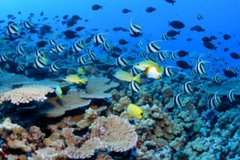Migaloo the White Whale Speaks
The Southern Cross University Whale Research Centre commenced land based research two weeks ago at Cape Byron lighthouse. Marine Science students & volunteers,
under the guidance of researcher Daniel Burns, have sighted approximately 1,400 whales during the 14 day study period. This is a record number of whales observed since research at the Cape began in 1981, when less than 10 whales were sighted in the same study period.
http://www.scu.edu.au/research/whales...
The population of this group of whales, the Antarctic Area V whales, was estimated to be between 45,000 and 60,000 before whaling commenced. When whaling ceased in Australia because of the lack of whales, there were an estimated 150 individuals remaining. We published a collaborative paper on the Antarctic Area V population in 2005. Using Photo-Identification 'mark re-capture' techniques we estimated the recovering population to be approximately 7,000. The population could now be around 10,000.
So we can feel a sense of pride as humans, that we have allowed the East Coast Australian Humpback Whale population to begin its recovery. People from all nations visit the Cape at this time of year to greet the whales as they pass. They breach occasionally, very probably to get a better view of the lighthouse. Cape Byron is a very important landmark for the whales on their migration north, being the most easterly point on the continent.
We present to you the voice of Migaloo, the White Whale. We thought it appropriate that Migaloo be granted the opportunity to speak before the meeting of the International Whaling Commission. As speakers are allowed only a few minutes to present their case, we extracted only the most poignant statements from our 1998 recording of Migaloo's two hour discourse. 'Migaloo' means 'White Fella'. He was named by Australian Aboriginal Elders.
The images are highlights from close extended pod encounters between 1998 and 2007. For images of Migaloo, please view the encounter as narrated by our intern Dave Williams:
http://www.youtube.com/watch?v=0vEj9g...
''One of the great thrills of my life was hearing and feeling Migaloo's voice pass through my body as he swam past The Oceania Project's research vessel on October 2, 1998.''
~Dave Williams
The sound pressure level of the whale's song is equivalent to that of a jet engine. It is speculated that the whale's song if unimpeded by land-masses could circle the globe and return to its source. Divers in close range of a singer have told us that their whole bodies vibrate with the frequencies.
The Oceania Project's
19th Whale Research Expedition
August 2008:
http://oceania.org.au/expedition/expe...
DVDs & Downloads:
http://oceania.org.au/iwhales/portal/...
Your community can adopt a Humpback Whale:
http://www.stopwhaling.com.au/site/c....
To celebrate the annual return of the Humpback Whales, sixty Australian communities are participating in the Humpback Icon Project. Each of these communities has adopted a known individual Humpback Whale from The Oceania Project's Fluke Catalogue:
http://www.stopwhaling.com.au/site/c....
Established in 1988 by Trish & Wally Franklin, The Oceania Project is an independent, non-profit research organization dedicated to the conservation and protection of whales, dolphins and the oceans.
The first phase of a long-term study of the Australian Humpback Whales has been the major work of The Oceania Project.
This research continues to be made possible by individuals who participate in The Oceania Project's Internship Program. To date, more than 1,300 interns have joined the annual whale research expeditions.






































